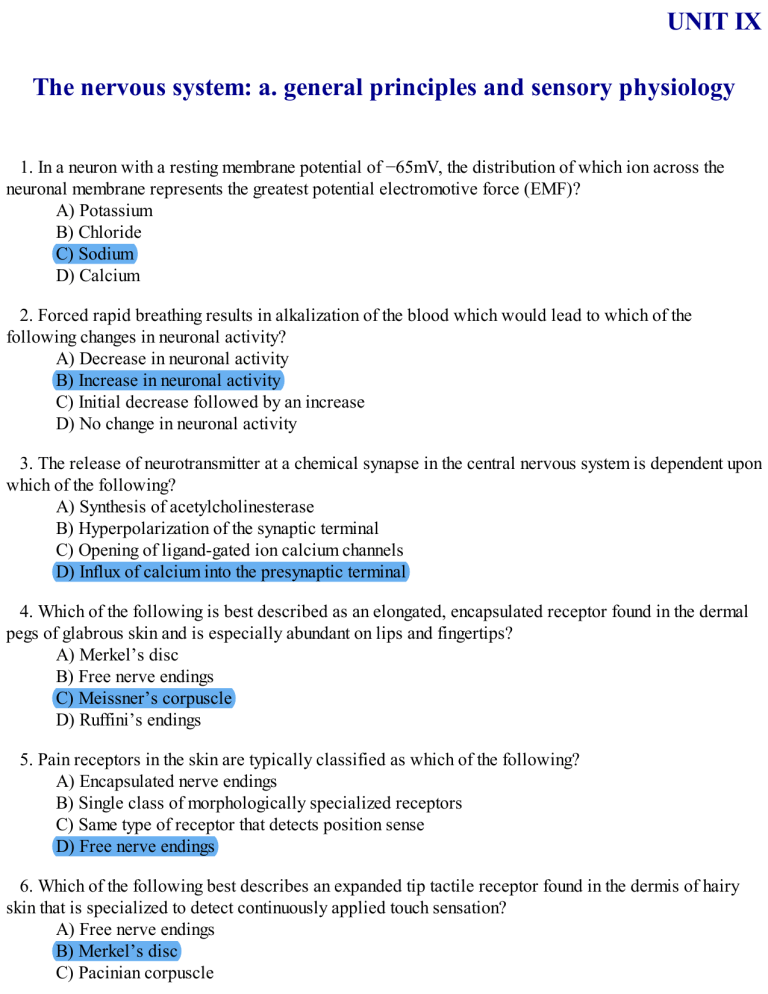What Best Describes the Role of Calcium in Synaptic Activity
Synaptic strength may be modified in an activity-dependent manner. Which of the following best describes the role of calcium in synaptic activity.

Solved Question 7 Which Best Describes The Role Of Calcium Chegg Com
Synaptic delay is the period of time for neurotransmitter chemicals released from the axon terminus of the sending neuron to cross the synaptic gap by diffusion and attach.

. The role of calcium ions Ca 2 in synaptic transmission is to a. ACalcium breaks down acetylcholine. B Calcium influx into the axon causes an action potential to propagate into the synaptic terminal.
For example high-frequency discharges in pre-synaptic fibers and concomitant strong synaptic activity may lead to a long. Repolarize the postsynaptic cell after. It has been found that presynaptic intracellular Ca 2 concentration could change synaptic efficacy and plays an indispensable role in synaptic plasticity and synaptic homeostasis Inglebert et al.
Calcium degrades neurotransmitter in the synaptic cleft. Because of the unique features of high calcium permeability and the voltage-dependent blockade by extracellular magnesium NMDA receptors are essential for mediating many forms of synaptic plasticity in the brain throughout development. Action potentials are electrical signals that tell muscle tissue to contract.
Calcium influx into the synaptic terminal causes vesicle fusion with the plasma membrane and the release of neurotransmitter. C Action potentials ultimately result in more calcium entering the neuron at the axon terminal. Our experiments suggest that synaptic activity can directly determine the subunit composition of a synaptic AMPAR by controlling the expression or targeting of edited subunits.
A Calcium influx into the synaptic terminal causes vesicle fusion with the plasma membrane and the release of neurotransmitter. The glutamate-induced calcium influx via calcium-permeable AMPA receptors would be expected to play a key role in the induction andor maintenance of activity-dependent synaptic plasticity that. Nevertheless this simple physiological behavior cannot describe the rich dynamics of physiological synaptic plasticity particularly the pathways from.
The roles that astrocytic calcium elevations play in neurophysiology and especially in modulation of neuronal activity have been intensely researched in recent years. BCalcium influx into the axon causes an action potential to propagate into the synaptic terminal. Calcium influx into the synaptic terminal causes vesicle fusion.
Calcium signals either from the extracellular milieu or from intracellular stores must be precisely regulated both temporally and spatially to achieve tight control over intracellular signaling. CCalcium diffuses across the synaptic cleft and binds to chemically gated channels on the postsynaptic cell. Mediate the release of neurotransmitter molecules from the presynaptic neuron.
Calcium influx into the axon causes an action potential to propagate into the synaptic terminal. Bind neurotransmitter molecules to the postsynaptic membrane. D Action potentials ultimately result in more calcium leaving the target cell at the post synaptic membrane.
As an action potential reaches a muscle cell it triggers calcium to release from the sarcoplasmic reticulum of the cells. Which of the following best describes the role of calcium in synaptic activity. The release of calcium helps propagate the muscle contraction and relaxation stages.
The calcium ions then flow into the cytoplasm and bind to the troponin and. This review will summarize the current understanding of the function of astrocytic calcium signaling in neurophysiological processes and discuss areas where the role of astrocytes remains. Calcium transients induced by presynaptic activity are assumed to represent calcium influx through NMDA receptors while calcium transients induced by postsynaptic spikes are assumed to represent activation of voltage-gated calcium channels 42 see 28 for more details of the model.
Synaptic strength describes the magnitude of post-synaptic currents or potentials in response to a pre-synaptic action potential. C Calcium breaks down acetylcholine. Calcium diffuses across the synaptic cleft and binds to receptors on the postsynaptic neuron.
The calcium ion Ca 2 is an important second messenger in the function and structure of nerve cell circuits in the brain. B Action potentials determine the amount of neurotransmitters that are released into the synaptic cleft. What is synaptic delay.
Ca 2 signalling regulates multiple neuronal functions such as neuronal growth exocytosis synaptic plasticity and cognitive function 33 35. Which of the following best describes the role of calcium in synaptic activity. What is the role of calcium in synaptic activity.

Solved Place The Following Steps 1 6 In The Order That Chegg Com

Solved Question 7 Which Best Describes The Role Of Calcium Chegg Com

No comments for "What Best Describes the Role of Calcium in Synaptic Activity"
Post a Comment